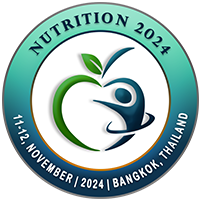
Nadjiam Djirabaye
Chadian Institute of Agronomic Research for Development - ITRAD, ChadTitle: Physicochemical Characterization of Nine Cassava (Manihot esculenta Crantz) Cultivars from Chad
Abstract
In Chad,
despite the multiple culinary uses of cassava leaves and tubers, their
nutritional values are untapped. In this study, the physicochemical compositions
and structure of nine cultivars were assessed. The proteins were obtained by
Kjeldahl’s method. Total sugars were determined according to the Luff-Schoorl
method. For starch content, the polarimetric method of Earle and Milner was
used. Mineral elements were carried out using an atomic ab[1]sorption
spectrophotometry. The cyanide was evaluated by the method of Williams and
Edwards. Significant variability has been demonstrated in the leaves and dry
tubers except for water content and dry matter. Analysis of the variances of
the components of the tubers reveals that the water contents of the cultivars
vary from 5.01% to 5.86%. The ash contents vary from 4.23% (cultivar DVA2) to
8.32% (cultivar DVL2). For total sugars, the values are between 53.63%
(cultivar DVL2) and 57.99% (cultivars DVL12 and KA0303). The fiber contents are
lower and vary from 1.74% (cultivar DVL12) to 1.92% (cultivars SB1366, DVA2,
TL0101 and PG1314). The starch content varies from 28.93% (cultivar DVL12) to
31.05% (cultivar SB1366). The variations in mineral constituents of the tubers
in mg/100g are Ca (145.21 - 250.08), Mg (83.89 - 165.22), P (147.34 - 360.78),
K (1534.50 - 3064.09), Zn (0.75 - 0.82) and Mn (0.78 - 0.89). Iron concentrations
are from 7.72 mg/100g (cultivar BA0909) to 60.62 mg/100g (cultivar DVA2).
Analysis of the variances of the leaf constituents reveals high contents of
Calcium for SB1366 (2108.41 mg/100g), of iron (Fe 54.26 mg/100g) and potassium
(K 1866.86 mg/100g) for DVL12, of phosphorus for TL0101 (471.87 mg/100g), of
phosphorus (470.36 mg/100g) and protein (30.74%) for PG1314, for magnesium for
DVA2 (383.41 mg/100g) and Copper for KA0303 (0.0147 mg/100g). The
concentrations of hydrocyanic acids are high in both leaves than fresh tubers
(85 - 150 ppm). Lowest values are observed in tubers (10 - 15 ppm) for cultivar
DVA2. Principal component analysis of the physicochemical characteristics of
the leaves revealed four groups: the first very rich in calcium, magnesium and
average potassium contents. Groups 2 and 3 are poor in calcium and magnesium
but Group 2 has the highest potassium content while Group 3 has an intermediate
content. Group 4 is very rich in calcium but low in magnesium and potassium. According
to tubers, three groups have been identified which are characterized by low,
intermediate and high contents in phosphorus. Cultivars SB1366, DVA2, DVL2,
TL0101 and PG1314 show promising nutritional values and chemical constituents
even if some have high levels of hydrocyanic acids.
In
conclusion, a significant variability of the physicochemical constituents was
demonstrated at the level of the leaves and tubers. The concentrations of
different minerals vary depending on the cultivar. The significant differences
observed between cultivars testify to their richness in nutrients. The
determination of the potential hydrogen cyanide identified cultivars that need
to be detoxified before human consumption.
Biography
TBA

